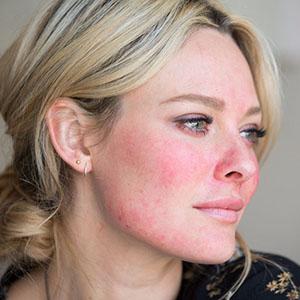
The colour red is often associated with energy, love, and passion. Wearing red – whether it be a slick of ruby lipstick or a slinky scarlet dress – can be a seen as a bold statement and one that indicates real confidence. But when it comes to redness of the skin in the form of rosacea, the opposite is often true. All too often I hear from patients that their confidence is suffering as a result of their rosacea.
Whilst there may not yet be a cure for rosacea, my team can potentially help you tone it down and make it considerably more manageable. So read on as I tackle the triggers and talk you through some top tips, as well as a tried and tested treatment. It could be just what you need to help you ditch the heavy coverage foundation and face the world with confidence.
‘A rose by any other name…’
The word ‘rosacea’ comes from the Latin word ‘rosa’ meaning rose-coloured. (A pretty name for a skin condition that can sadly cause a great deal of distress for the sufferer.)
The British Skin Foundation describes rosacea as ‘A common skin condition, usually occurring on the face, which predominantly affects fair-skinned but may affect all skin types in people aged 40 to 60 years old. It is more common in women but when affecting men, it may be more severe. It is a chronic condition, and can persist for a long time and, in any individual, the severity tends to fluctuate’ (Ref 1).
Rosacea typically affects the central areas of the face, including the cheeks, forehead, chin, and nose, and is characterised by a persistent red flush to the skin. This colouration is caused by dilated blood vessels and is sometimes accompanied by small bumps and pus-filled spots that look similar to acne – making it quite different to that youthful rosy-cheeked blush we often try to emulate with the help of a soft pink-hued blusher.
Blushing with embarrassment
We all have a tendency to blush when we’re embarrassed – it’s a natural bodily reaction. Rosacea can often begin as a tendency to blush easily, but as small, dilated blood vessels (erythema and telangiectasia) start to develop across the face, the redness can become more permanent.
In some cases, the skin might start to swell (known as lymphoedema). It might feel itchy, sore, or stingy, and bumps may appear. Over time, the redness can become more noticeable, even if the sufferer is wearing foundation.
Rosacea triggers
There are several factors which are known to trigger episodes of rosacea. Here are the top 10 ranked in order (Ref 2):
- Sun exposure
- Emotional stress
- Exposure to high and low temperatures
- Wind
- Heavy exercise
- Alcohol consumption
- Hot baths
- Spicy foods
- Humidity
- Use of particular cosmetics, especially those containing ingredients such as alcohol, menthol, witch hazel, and eucalyptus oil
Can menopause increase the risk of rosacea?
The hormonal imbalances in menopause, and the perimenopausal period leading up to it, can bring about significant changes to the skin, just as earlier teenage years can. Acne and rosacea are two of the many skin issues that can effect women during these periods.
Top tips to tone it down
Sadly, there is no known cure for rosacea. However, it is possible to limit the severity of the condition by trying to avoid the triggers listed above, where possible, in addition to the following:
- Wear sunscreen everyday
- Use a mild cleanser and avoid harsh scrubbing
- Follow with a gentle moisturiser
- Women experiencing menopause consider HRT / BHRT to balance hormone levels
Effective rosacea treatments
The NHS recommends three ways to manage the symptoms, dependent on the individual case. These include the application of topical creams, taking antibiotics, or undergoing Intense Pulsed Light treatment, also known as IPL (Ref 3).
The latter is where my team can help and the results are impressive. ‘Studies showed that IPL significantly reduces erythema and telangiectasia of rosacea, and this is sustained for at least 6 months’ (Ref 4).
IPL treatment at DRVICTORIA™ Clinic
At the clinic we use the Lynton EXCELIGHT®, one of the most advanced IPL skin rejuvenation systems available. As a Lynton Gold Approved Clinic, you can be confident that our IPL is annually serviced and calibrated, and that all our team are trained to an extremely high standard.
What happens during an IPL treatment?
A layer of chilled gel is applied to your skin to help guide the light. The light guide is placed onto your skin and a short pulse of light is released. The applicator is passed over your skin several times. Each pulse of light treats a large area of skin and so the duration of the treatment is very short, usually 15-45 minutes, depending on the size of your treatment area.
What does IPL feel like?
IPL is mildly uncomfortable, but no anaesthesia is required. Many people describe the sensation as similar to the flick of an elastic band!
Immediately after treatment, your skin may appear red and you might experience a warm tingling sensation. However, we always finish by applying a calming gel to ease any discomfort, and the redness should disappear within just a couple of hours.
Discover how we can help you
To find out more about the benefits of our IPL service and if it is appropriate for you - book an IPL consultation for facial redness. My knowledgeable team will spend 30 minutes to examine your facial redness, discuss your medical history, explain the treatment and advise if it is suitable for you.
If you are in the menopause years contact the clinic on 0131 226 9610 to arrange a consultation with myself to discuss BHRT and how balancing your hormones can help.
Dr Victoria
Author's experience:
Dr Victoria has almost 20 years experience in aesthetic medicine and treating skin conditions. Amongst her numerous certifications is advanced laser and IPL for skin conditions and Bio-identical Hormone Replacement Therapy giving her a clear perspective on the subject matter.
Reference links:
- Ref 1: British Skin Foundation, Rosacea
- Ref 2: National Rosacea Society, Rosacea triggers
- Ref 3: NHS, Rosacea
- Ref 4: Photomedicine: Advances in Medical Practice, Edited by Yohei Tanaka, 2017
Resource links:
- British Association of Dermatologists, Rosacea
- Primary Care Dermatology Society, Rosacea
- Everyday Health, The 9 Most Common Triggers for a Rosacea Flare
- British Journal of Dermatology, Treatment of Rosacea with Intense Pulsed Light: Significant Improvement and Long-Lasting Results, Papageorgiou, Clayton, Norwood, Chopra, and Rustin, 2008
- Dermatology and Therapy, Perceptions on the Psychological Impact of Facial Erythema Associated with Rosacea: Results of International Survey, Dirschka, Micali, Papadopoulos, Tan, Layton, and Moore, 2015






